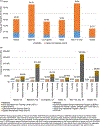Building the Case for Localized Approaches to HIV: Structural Conditions and Health System Capacity to Address the HIV/AIDS Epidemic in Six US Cities
- PMID: 29802550
- PMCID: PMC6076864
- DOI: 10.1007/s10461-018-2166-6
Building the Case for Localized Approaches to HIV: Structural Conditions and Health System Capacity to Address the HIV/AIDS Epidemic in Six US Cities
Abstract
Since the discovery of the secondary preventive benefits of antiretroviral therapy, national and international governing bodies have called for countries to reach 90% diagnosis, ART engagement and viral suppression among people living with HIV/AIDS. The US HIV epidemic is dispersed primarily across large urban centers, each with different underlying epidemiological and structural features. We selected six US cities, including Atlanta, Baltimore, Los Angeles, Miami, New York, and Seattle, with the objective of demonstrating the breadth of epidemiological and structural differences affecting the HIV/AIDS response across the US. We synthesized current and publicly-available surveillance, legal statutes, entitlement and discretionary funding, and service location data for each city. The vast differences we observed in each domain reinforce disparities in access to HIV treatment and prevention, and necessitate targeted, localized strategies to optimize the limited resources available for each city's HIV/AIDS response.
Keywords: Epidemiology; HIV; Health system; Policy.
Conflict of interest statement
Conflict of Interest:The authors declare that they have no conflict of interest.
Figures
References
-
- The HIV epidemic can be stopped. Nature. 2015;523(7559):127. - PubMed
-
- The Joint United Nations Programme on HIV/AIDS (UNAIDS). 90–90-90 An ambitious treatment target to help end the AIDS epidemic 2014.
-
- Office of National AIDS Policy. National HIV/AIDS Strategy for the United States: Updated to 20202015.
-
- The Henry J Kaiser Family Foundation. U.S. Federal Funding for HIV/AIDS: Trends over time. 2016. [4 November 2016]; Available from: http://kff.org/global-health-policy/fact-sheet/u-s-federal- funding-for-....
Publication types
MeSH terms
Substances
Grants and funding
LinkOut - more resources
Full Text Sources
Other Literature Sources
Medical




